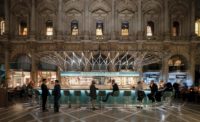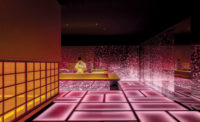Restaurants, bars, and cafés have long shaped the character of neighborhoods, cities, and entire cultures, but in recent decades, architecture took its place alongside the cuisine as a defining feature of a meal. Now, as chefs reach for local ingredients in their craft-focused cooking, designers are creating a new idea of authenticity with their food-focused spaces.
In her captivating memoir, Blood, Bones & Butter, the chef Gabrielle Hamilton writes about opening her signature New York City restaurant, Prune, on a block of the Lower East Side still populated by “random derelicts” who would leave their messes behind in her side alley. That was in 1999, at the moment when the lamp of urban gentrification was passing from the hands of artists to those of chefs, where it remains still. In any American city old enough to have an old downtown, the frontier between derelicts and gentrifiers is a street of 19th-century brick warehouses or new glass-walled condominiums, lined with folding chalkboard menu signs and outdoor café tables, irrespective of the local climate. Increasingly in this postindustrial era, the preparation and sale of food are what drives urban development, leapfrogging ahead of actual changes in demographics. “Restaurants used to want a good address,” muses Rozanne Gold, a New York chef and restaurant consultant. “But now, chefs starting up are looking for cheap rents, and out-of-the-way locations actually add to the cachet of a place.”
A city by its very existence calls into being wholesale markets, grocers, bakeries, taverns, and restaurants, which in turn become part of its identity. Think of Pike Place Market in Seattle, Zabar's in New York, Bookbinder's in Philadelphia, or for that matter Applebee's, which evokes a generic American suburb the way the Tour d'Argent does Paris. And restaurants also evoke their period: step into a room where gilded Buddhas gaze at artful arrangements of black river stones and you are transported back to the lemongrass-scented, ponzu-dipped world of a decade ago. People still eat duck-kimchi samosas, but the design world has moved on. The fields of organic m'che on which the herd of urban sophisticates now grazes must be watered regularly with the blood of architects.
It was only in 1959, when the Four Seasons opened in the Seagram Building with Philip Johnson's electrifying High Modernist design, that fine restaurants began to think seriously about architecture as part of a total aesthetic experience. Before that, temples of haute cuisine like New York's Le Pavillon hewed to a formula of one part foie gras to three parts pomp in a setting of generic Continental luxury. But for decades since, it has been assumed that a high-end restaurant needed a high-concept design. By the time Adam Tihany was designing suave showplaces like Le Cirque 2000 in Manhattan, David Rockwell had brought his brand of high-voltage “entertainment architecture” to restaurants as diverse as Planet Hollywood and Nobu. His Nordic-ski-lodge design for the now-closed Christer's in New York was described, admiringly, as “L.L. Bean on acid,” while Barbara Lazaroff's fuchsia-drenched design for Chinois on Main, Wolfgang Puck's Asian-fusion palace in Santa Monica, California, flaunted the description “Felliniesque.” Restaurant design was also a launchpad for some of today's most ambitious avant-gardists, such as Morphosis, the studio whose signature project of the 1980s was the glass-walled Kate Mantilini in Beverly Hills. Five years after it was closed by a fire, the Brasserie, the more modest sibling of the Four Seasons, was reimagined by Diller + Scofidio (now Diller Scofidio + Renfro) in 2000 as a homage to the original 1959 design. A bank of video screens showing customers descending an updated version of Johnson's iconic staircase automated the business of making a grand entrance, which so many ingenues once struggled to master on their own. Translucent panels separating the men's and women's rooms, which share a sink, lend a touch of titillation to these previously overlooked spaces, and helped propel the trend toward making restaurant bathrooms a design statement in their own right.
If designs inspired by Fellini or acid trips no longer have the same salience, it's because the zeitgeist has shifted toward “authenticity.” This is a concept originally applied to restaurants where the pagodas on the wallpaper signified an authentically Chinese No. 1 combination plate. (Dragons and bamboo now constitute a hip, ironic counterpoint to the updated Chinese-American dishes at Mission Chinese Food in New York.) Today, authenticity more often connotes the trio of values exalted by chefs like Alice Waters of Berkeley's Chez Panisse and food writers like Michael Pollan: fresh, local, seasonal. In an era when you can buy strawberries at any supermarket in February, the appeal of exotic, out-of-season ingredients has faded; chefs now pride themselves on serving fiddlehead ferns, ramps, and morels foraged in the local woods, harnessing the restless appetites of the bourgeoisie for sustainability. Authenticity implies beer brewed within the city limits in a brewery housed in an old power plant and vegetables that arrive at the kitchen in the back of a farmer's pickup, or from a nearby urban garden.
“Farm” is perhaps the most powerful word in the restaurant lexicon today; if anyone kept a list of new restaurant names the way the Social Security Administration does of baby names, “Farm” would probably rank near the top for the past decade, along with its derivatives, such as “Crop” and “Harvest.” There is a Farm of Beverly Hills, whose rustic knickknacks, slat-back side chairs, and chicken pot pie evoke nostalgia for a bygone era that cannot possibly have been experienced by one customer in a thousand. Brooklyn has a restaurant called Flatbush Farm and a Brooklyn Farmacy, a soda fountain serving artisanal sandwiches and house-made soft drinks in a penny-tiled, tin-ceilinged old drugstore. There's a Harvest in Philadelphia as well as an unrelated one in St. Louis and another in Louisville. The Kentucky restaurant has a Zenlike austerity of design, featuring not much more than large photographs of the farmers who grew the food and a stark sculpture of woven bare twigs.
But “authenticity” doesn't have to conjure ceramic cows on painted wood shelves. Done right, it means local, historically appropriate, and functional—like Jensen Architects' design for the Healdsburg, California, SHED, a market, café, and “fermentation bar” in a metal-and-glass interpretation of a 19th-century grange hall. Crop, in downtown Cleveland, is housed in an immense, high-ceilinged bank building, with a vault that serves as a private dining room. The location of Reilly Craft Pizza & Drink, in Tucson, was known from 1908 until 1990 as the Reilly Funeral Parlor.
Down the street from the Louisville Harvest, in a neighborhood (NuLu) of brick storefronts and shotgun houses, are Garage Bar, in an abandoned service station, and Decca, occupying a former homeless shelter—both products of the Louisville firm Tucker Booker Donhoff + Partners. (Decca, named after the record label, was a collaboration with architect Charles Gabhart.) Decca is a small monument to the idea of sustainability, from the geothermal wells that temper the air inside to chef Annie Pettry's menu of locally sourced ingredients cooked on a wood-burning grill fired with fruitwood harvested by Dave the Mountain Man, whose informal title is “wood sommelier.” The unpretentious design, of bare-brick walls and floors in a basketweave parquet of dark and light corkwood, are meant to be sustainable, too, in the sense of sustaining the interest of customers over what co-owner Chad Sheffield hopes will be a long run: “You can go to these beautiful places that knock your eyes out, but once you go two or three times the effect is gone.” Some of the most interesting work in the design world right now is taking shape around food, and several noteworthy projects appear in this special section. Which of them will stand the test of time?
People |
Products |














Post a comment to this article
Report Abusive Comment